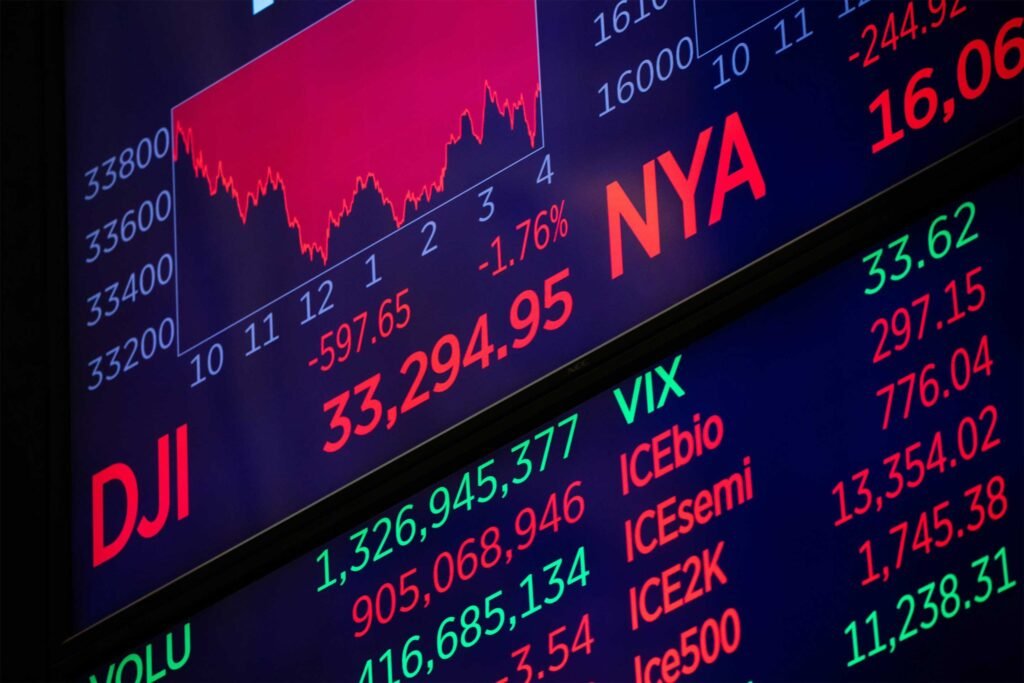Early August turmoil shows how easy it is for stock market jitters to snowball among investors.
The 24-hour period between Aug. 5 and Aug. 6 was a whirlwind for stock market investors, who likely didn’t bargain for the volatile ride.
After a week of buildup, the market reacted adversely to worries over a U.S. recession and angst over the Bank of Japan boosting interest rates at a time when investors were borrowing the yen on the cheap to buy higher-risk stocks and derivatives.
During those 24 hours, Japan’s benchmark Nikkei 225 stock index lost 12% and gained back 10%, while the U.S. Dow Jones Industrial Average shed more than 1,030 points and gained back 550 points in highly chaotic trading action.
The sequence proved that, once again, stock market investing is fraught with risk and that talk of a market collapse isn’t hyperbole.
“We’re seeing the market’s emotional side right now,” says Aaron Sherman, president of Odyssey Group Wealth Advisors in Lancaster, Pennsylvania. “As much as the market may seem to be driven by pure numbers, dollars and cents, rational explanations of market activity rarely tell the whole story.”
Sherman says investors are seeing market psychology shift abruptly from “it’s all good” to “the sky is falling” without much justification this week. “Yes, there are signs the economy is slowing, but it’s not falling off a cliff,” he says.
That’s the good news, as the U.S. economy and the stock market aren’t out of the woods yet. Keep an eye on these seven “market crash” factors that can send stocks tumbling again at a moment’s notice:
- The job market.
- The Federal Reserve.
- Growth expectations vs. risks.
- Volatility scares.
- Stubborn inflation.
- Investor sentiment.
- Negative economic data.
The Market
Among the other economic issues impacting stocks these days, the U.S. labor market stands out with flashing yellow lights.
“July’s employment report was the first signal in a long time that our thus-far resilient economy may be on slightly shakier ground than economists predicted,” says Clemens Kownatzki, professor of finance at Pepperdine Graziadio Business School.
That concept isn’t complicated when people are less certain about their jobs, household finances and ability to afford purchases.
“Households respond by effectively tightening their belts and reducing spending, hence less economic activity,” Kownatzki says. “Still, U.S. companies are better prepared to manage potential economic downturns, having learned plenty of lessons from the last recession.”
The Reserve
The recent market downswing was largely due to the flood of weak economic data in early August. Some investors expected stagnant labor and consumer sentiment numbers to sway the recent Federal Reserve Open Market Committee decision to hold off on rate cuts.
“It’s hard to argue with that,” says Eric Leve, chief investment officer at Bailard in San Mateo, California. “If you take the Fed at its word, you should be further convinced by its shift from ‘highly attentive to inflation risks’ in June to ‘attentive to both sides of its dual mandate’ at last week’s meeting.”
Leve says the Fed’s interest rate policy, as measured by real rates, is very restrictive right now. He also notes that if the Fed’s concern is full employment, the rationale for lowering rates becomes ever clearer. “The market is now pricing in two rate cuts for the Fed’s September meeting,” Leve says. “This seems reasonable and would probably signal less anxiety on the Fed’s part than doing a rare mid-meeting rate cut.” In the meantime, Leve notes that taking “a little froth” off the market isn’t terrible. “It may set the market up for a stronger post-election rally,” he adds.
Growth vs. Risks
Growth expectations and risks are the two main drivers of individual stock prices and the overall stock market, and each has a significant (and potentially volatile) impact on the market.
“Stock prices reflected the expectation of future profits and cash flows, discounted to the present,” says Stephen Foerster, professor of finance at the Ivey Business School at Western University in Ontario, Canada. “The discount rate, in part, captures risks. All else equal, higher expected growth should be reflected in higher stock prices, while higher risk should have the opposite effect.”
For example, a recent catalyst for negative stock market performance was a disappointing July jobs report. “America was still adding jobs, but below expectations,” Foerster explains. “The unemployment rate also rose, and investors seemed to have switched focus from inflation to jobs. The fear is that this may signify a weakening economy and lower, or possibly negative, GDP growth in the coming months or quarters.”
Scares
A major measure of overall market risk is the CBOE Volatility Index, which pegs the stock market’s 30-day volatility expectations. The VIX rose alarmingly to 65 on Aug. 5 as stocks were tanking. That’s a 180% boost, representing the highest one-day rise in the index ever. The VIX did fall to 38 by the day’s end, but the choppiness put a fright into even the most experienced market traders.
That makes the VIX a gauge worth tracking if you’re worried about market stability.
“The VIX reflects investors’ expectation of market volatility,” Foerster says. “Its average level is around 20 times, and as recently as early July, the VIX was at a very low level of around 12. As the VIX rose on Aug. 5, it combined weaker growth expectations with higher risk. So it’s no surprise that stock markets saw a substantial downward price movement.”
Stubborn
Higher inflation is a major focus because it drives the Federal Reserve’s policy decisions.
“This will still be important to watch at the next report, and a low print will likely point toward a Fed cut and, therefore, a market rise,” says Stephen Kates, a certified financial planner and analyst at RetireGuide.com and Annuity.org.
Investors are looking for any indication that the economy is stalling and nudging the Fed to cut rates. “Lower rates will ease borrowing costs and lower mortgage rates, both of which will unlock more spending and investment from businesses and consumers alike,” Kate notes.
For those with excess cash earning 4% to 5% on the sidelines, you’ll need to plan for that money. “Rates will not be this high for much longer, and putting that money to work somewhere is an important project for the rest of 2024,” Kate adds.
Investor
There’s an old saying on Wall Street that markets don’t trade on the underlying economy; they trade on sentiment. “Currently, the sentiment that the U.S. economy avoided a recession has been very stretched, despite months and months of weakening and broadening data that suggest the economy is vulnerable,” says Jeff Klingelhofer, co-head of investments at Santa Fe, New Mexico-based Thornburg Investment Management.
Klingelhofer believes the U.S. is already in a recession for low-income borrowers.
“The erosion in spending power and sentiment is spreading to the middle-income borrower, and it’s metastasizing economy-wide,” he says. “It’s impossible to know, but the risk of recession is and has been high, and yet markets were ignoring the possibility.”
Negative Economic Data
The current market shakedown is complex, but the latest bumps and bruises stem largely from the downbeat July jobs report.
“Add to that dreadful ISM manufacturing numbers, and now a meltdown in Japan along with geopolitical tensions in the Middle East, and you have all the elements of a swift correction,” says Nancy Tengler, CEO of Laffer Tengler Investments in Paradise Valley, Arizona. “The question is whether it melts into a full-fledged bear market.”
Tengler tilts to the positive side of the recession debate for the following reasons:
- The market experiences an average correction (down 5% to 10%) every 12 months. “We were overdue,” Tengler says.
- The sell-off in response to weaker job numbers and unemployment is likely an overreaction. “This metric is notoriously unreliable, with major revisions often offered after the fact,” she notes.
- U.S. productivity numbers were much better than expected, and unit labor costs were lower than expected. “Additionally, the previous quarter was revised up and down, respectively. This is good news,” Tengler adds. “With productivity improving last quarter by 2.3%, we continue to think that is the magic bullet in a slowing economic environment and higher interest rates.”
- Earnings, particularly in the technology realm, have been robust. “After the latest round of earnings calls, we are optimistic that AI is not a bubble, that margins are expanding at the specific company level, and that top-line growth is still healthy in the mid-single digits,” Tengler says.
Tengler says her investment team is still focusing on old-economy companies that have pivoted to digitization, cloud computing, generative AI solutions, and the suppliers of technology’s versions of picks and shovels.
“We have remained disciplined and trimmed a host of our technology and communications services names in July,” she says. “We’ll be looking for an opportunity to add back to the highest-quality stocks at lower prices.”
Tengler points to the 2022 tech swoon, where investors were able to pick off Microsoft Corp. (MSFT) at approximately $220. “At last week’s closing price of $408, investors have been rewarded handsomely even though Microsoft stock is down about 15% from its highs,” she says.











Leave a Reply